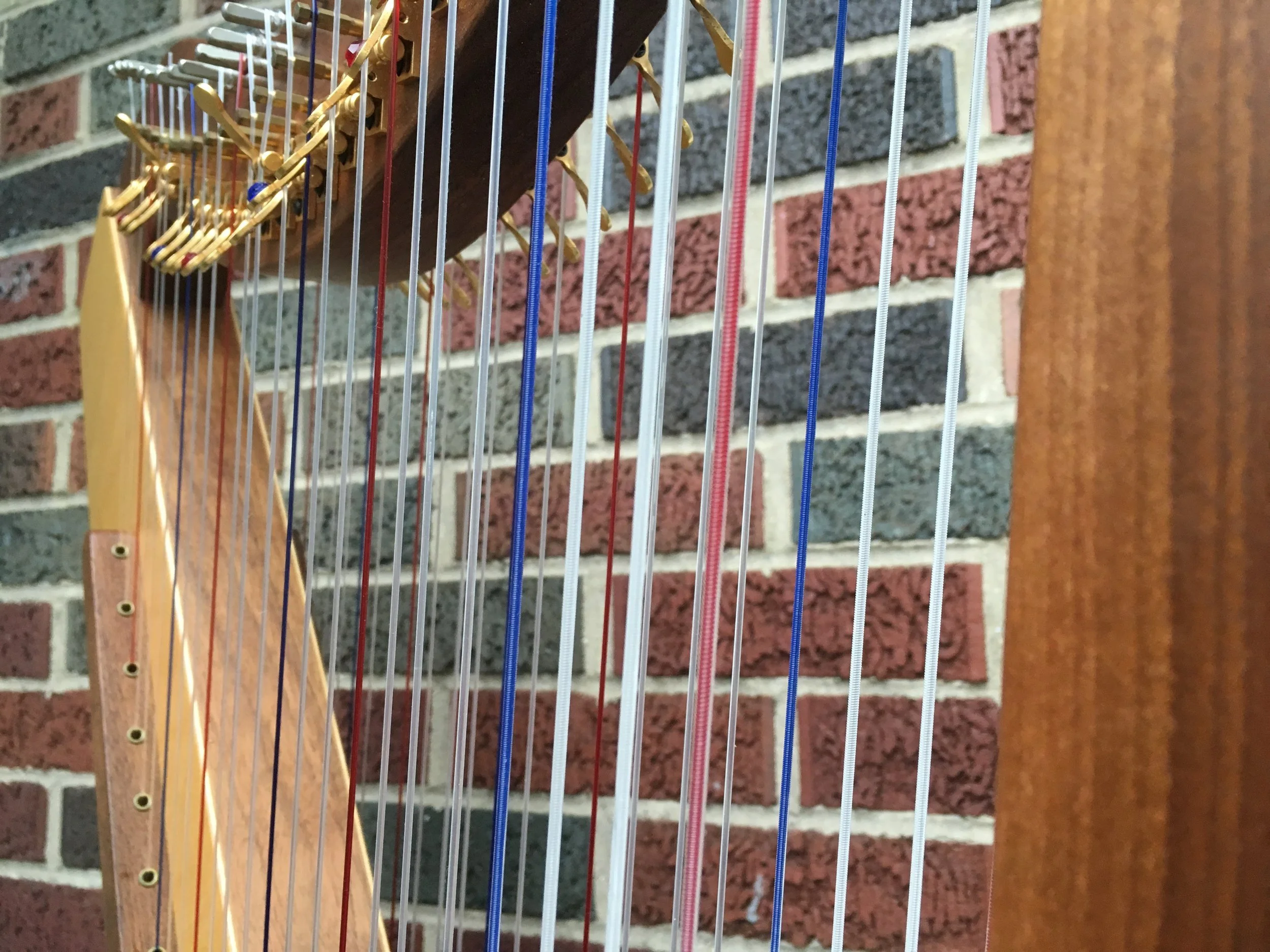Double-strung harp
How is double-strung different from a “normal” harp?
Most harps only have one row of strings. Some have more...
This is a photo of a normal lever harp. You can see a single row of white, red, and blue strings. At the right of the picture, you can see the soundboard, with the darker piece of wood that the strings go into.
A double-strung harp has two rows of strings. The rows, or courses, are exactly the same strings, parallel to each other. Each side has its own set of levers.
In this picture, on the near side, look at the top, and you can see that the closest string is red. Look to the left of that closest red string. You can see a white and a blue and another white string. These are on the far side of the harp, a second row of strings, same as the first.
When harpers who have never played a double sit down at mine, the first thing they do is look at the placement of their right hand...which means they are looking through two sets of strings. They immediately blink a lot and ask how I play this without getting dizzy.
It took me a week to get used to it, and I've been fine on both single and double ever since.
Why play a double-strung harp?
Your hands don't run into each other. If you've played the “regular” (single-course) harp for a long time, you might not even realize that you make adjustments in your arrangements to prevent your left hand from overlapping notes in your right hand. On a single-course harp, when you are doing a C chord in your left, but your right hand is playing C in the melody, you have to make sure your left thumb doesn't hit your right finger. This doesn't happen on a double-strung. This is the most difficult difference to explain to someone who is not familiar with harps, but it is my number one reason for loving the double-strung.
Easier improvising. With a row of strings for each hand, your hands will never run into each other. Set the levers of each side in a different key for extra fun—one side can be gliss tuning.
Better-sounding repeated notes. For songs with lots of repeated notes, you can split the playing between rows, so you don’t have to dampen the same string to play it again.
Fewer mid-song lever changes. Set your accidentals on one side so you don’t have to flip in the middle of a song.
More resonance. Doubling the same strings gives a fuller harp sound, because there are more strings to vibrate sympathetically.
Special effects. Echo yourself by playing the same melody with both hands (imagine what bisbigliando sounds like). Play the same notes at the same time for more volume.
Twice the strings in half the space. Take arrangements for a larger harp and move the left hand up an octave.
Find out more from my book, Enjoy the Double-Strung Harp.
A brief history of the double-strung, an explanation of its benefits, and beautiful demonstrations.
Laurie discusses some common concerns about the double-strung (like adjusting your eyes to focus on the right sting) and demonstrates some of the more advanced features (like how to flip levers on the blind side and setting certain ranges to different keys).
Double-strung resources
24 arrangements, 7 etudes, and 44 exercises. For all levels: harp newbies, single-course players, and experienced doublers. 150 pages. Get Enjoy the Double-Strung Harp.
I wrote Enjoy the Double-Strung Harp for double-strung harp players who are brand new to the instrument, who already know how to play the single-course harp, or who already play the double-strung harp. How do you make it sound like a double? How do you focus with two sets of strings? And then, what do you do next? Get the hard copy or PDF.
See more sheet music I arranged for double-strung harp and other double-strung harp music.
If you’re looking to buy a double-strung harp, Marini Made Harps➚ has the model that is most similar to the double-strung you see pictured here on my site. See a list of other double-strung harp luthiers.
Ready to contact me about learning the double-strung or regular lever harp? Or, first find out more about me.


